.
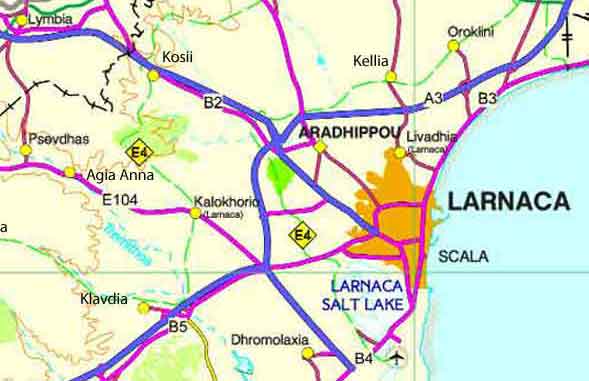
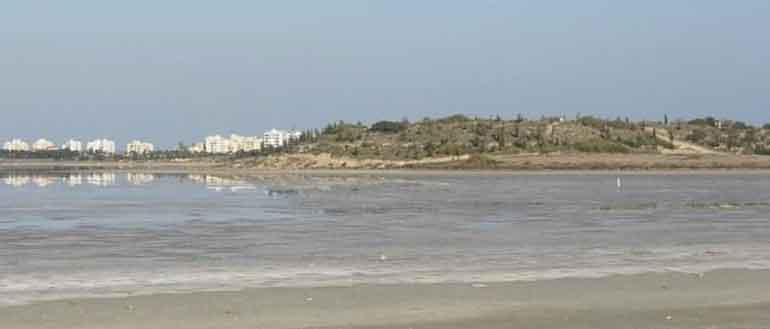
Larnaca Salt Lakes in winter with part of Larnaca city in the background (Source).
Coordinates 34°54′N, 33°37′E
Basin countries Cyprus
Surface area 1,585 hectares[1]
Average depth 1 m
Surface elevation 0 metres
Settlements Larnaca
Larnaca Salt Lake (Greek:Αλυκή Λάρνακας) lies to the west of the town of Larnaca. It is a complex network of four salt lakes (3 of them interconnected) of different sizes. The largest is lake Aliki followed by lake Orphani, lake Soros and lake Spiro.[1] They form the second largest salt lake in Cyprus after the Limassol Salt Lake. The total surface area of the lakes adds up to 2.2 km2 and being just off the road leading to Larnaca International Airport is one of the most distinctive landmarks of the area. It is considered one of the most important wetlands of Cyprus and it has been declared a Ramsar site, Natura 2000 site, Special Protected Area under the Barcelona Convention[2] and an Important Bird Area (IBA).[3] It is surrounded by halophytic scrubland and on its bank lies the Hala Sultan Tekke, one of the holiest of shrines within Ottoman Islam. It houses Umm Haram’s tomb, Muhammad's 'wet-nurse'.
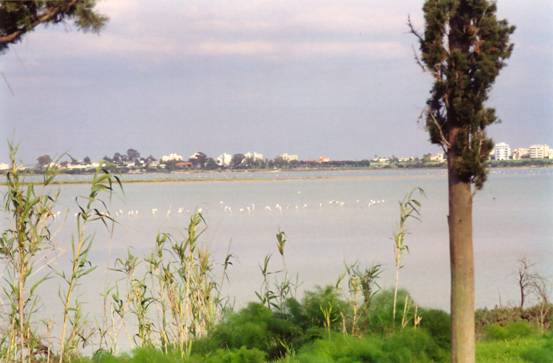
Larnaca Salt Lake, Flamingos, Photo : Augusta Stylianou
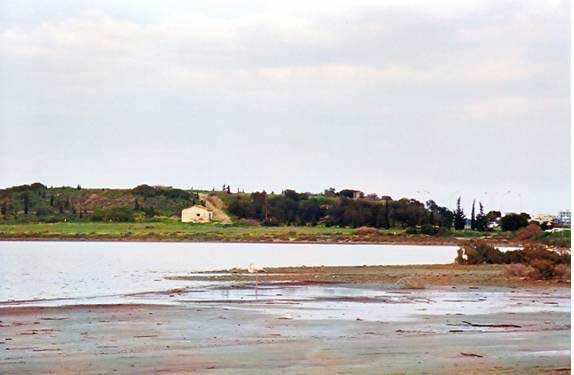
Larnaca Salt Lake, Flamingo, Photo : Augusta Stylianou

Larnaca Salt Lake, Flamingos, Photo : Augusta Stylianou
Besides its picturesque beauty, the lake is the haunt of 85 species of water-birds with estimated populations between 20,000-38,000.[citation needed] It is one of the important migratory passages through Cyprus. Among them are 2-12,000 flamingoes (Phoenicopterus ruber)[4] which spend the winter months there feeding off populations of the brine shrimp Artemia salina.[1] Other important bird species are the Grus grus, Charadrius alexandrinus, Larus ridibundus, Himantopus himantopus, Burhinus oedicnemus, Hoplopterus spinosus, Oenanthe cypriaca and Sylvia melanothorax.[citation needed] Flocks of birdwatchers gather to observe the blaze of pink from flamingoes as they gather in the centre of the lake but also the other important migrants. The Larnaca Salt Lake complex was declared as a protected area by a decision of the Council of Ministers in 1997.[5] Recent evidence suggests that contrary to previous belief the Greater Flamingo, (Phoenicopterus rubber) not only stops over but also breeds on this wetland.[6]
During the winter months the lake fills with water whilst in the summer the water evaporates, leaving a crust of salt and a haze of grey dust. According to legend, the lake's saltiness stems from St Lazarus' request of an old woman for food and drink. She refused, claiming her vines had dried up, to which Lazarus replied: "may your vines be dry and be a salt lake forever more." A more scientific explanation is that the salt water penetrates the porous rock between the lake and the sea, making the water very salty.
Salt harvested from this lake used to be one of the island's major exports, being collected by donkeys, carried to the edge of the lake and piled up into huge pyramidal heaps. With rising labour costs harvesting dwindled to a negligible amount and stopped altogether in 1986[1] as the island imports most of this commodity.
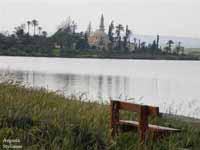
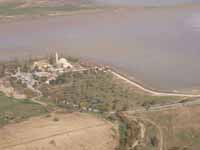
Larnaca Salt Lake with Hala Sultan Tekke, Larnaca Salt Lake with Hala Sultan Tekke,
References
- ^ a b c Report of the environmental audit of the city of Larnaca (PDF). Medcities (May 1999). Retrieved on March 29, 2007.
- ^ Kassinis, Nicolaos; Michalis Antoniou (October 2006). Proceedings of the first symposium on the Mediterranean action plan for the conservation of marine and coastal birds (p94) (PDF). Retrieved on March 29, 2007.
- ^ Iezekiel S., Makris C., Antoniou A. (2004) Important Bird Areas of European Union Importance in Cyprus. Birdlife Cyprus, Lefkosia 2004.
- ^ BirdLife IBA Factsheet - Larnaca salt-lake. BirdLife International (2006). Retrieved on March 25, 2007.
- ^ Hadjichristoforou, Myroula (8 December 2004). 5th European Regional Meeting on the implementation and effectiveness of the Ramsar Convention (PDF). Ramsar. Retrieved on March 25, 2007.
- ^ Hadjisterkotis, E.; M. Charalambides, (September 30, 2005). "The first evidence for the breeding of the Greater FlamingoPhoenicopterus ruber on Cyprus (Erster Brutnachweis des Flamingos Phoenicopterus ruber auf Zypern)". Zeitschrift für Jagdwissenschaft 48 (Supplement 1): 72-76. DOI:10.1007/BF02192394. Retrieved on 2007-03-25.
| Ancient Greece
Science, Technology , Medicine , Warfare, , Biographies , Life , Cities/Places/Maps , Arts , Literature , Philosophy ,Olympics, Mythology , History , Images Medieval Greece / Byzantine Empire Science, Technology, Arts, , Warfare , Literature, Biographies, Icons, History Modern Greece Cities, Islands, Regions, Fauna/Flora ,Biographies , History , Warfare, Science/Technology, Literature, Music , Arts , Film/Actors , Sport , Fashion --- |

